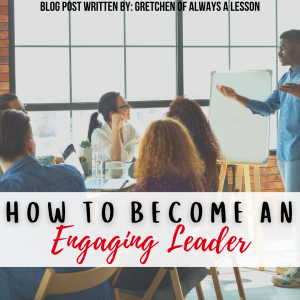How to Become an Engaging Leader
Becoming an engaging leader can be a natural transition for educators. Teachers spend an inordinate amount of time designing and delivering lessons that authentically engage their students. This results in achievement gains for students all while improving teacher proficiency.
Educators can leverage this skillset in their approach to leadership. It is essential to be engaging as a leader so that people want to listen to what you have to say and are motivated to carry out your message when asked.
 Three simple ways to become an engaging leader, regardless of setting, include:
Three simple ways to become an engaging leader, regardless of setting, include:
- Use eye contact– Connecting to your audience with your eyes helps keep them involved in the dialogue, even if it is heavily one sided. The connection, almost like an invisible leash, encourages others to remain on track in the conversation.
- Personalize your message– Use names and personal details to connect. Knowing your audience is essential to ensuring your message lands and your leadership impacts.
- Speak through story– Making your message memorable creates an enjoyable journey for the learner. Using stories to explain a point brings meaning, builds relationships and sparks joy in the learning.
In addition to the tips above, educational leaders communicate through professional development sessions, in-person conversations and email. Specific tips for remaining engaging in those settings are listed below:
Become an engaging leader in Professional Development [PD] Sessions
-
- Work the room– Moving around while leading others in their learning can help keep the audience from drifting off. As you get closer, your proximity keeps them alert. Movement also adds an element of curiosity because the audience doesn’t know where you’ll end up next.
- Parcel out info– It can be hard to hold attention when sharing information so deliver learning in bite-sized chunks. They will not tune out, get lost or be overwhelmed. This leaves room for audience interaction to help digest the information.
- Show, don’t tell– Using images or demonstrations keeps the audience’s attention more than talking to them at nauseam. Using large movements to demonstrate an idea or principle makes the learning memorable and enjoyable.
Remain an engaging leader during in-person conversations
-
- Lean in– When having a one-on-one conversation with someone, leaning in encourages attention from the other party. It makes that person feel important and that what you have to say could be of value to them.
- Ask follow up questions– By repeating information shared during an in-person conversation or asking follow up questions shows interest in the thoughts of others. This intention promotes engagement on deeper levels.
Follow-Through as an engaging leader via e-mail
-
- Motivational words– Keeping the tone of emails upbeat and motivational encourages the receiver to continue reading the whole message and all subsequent emails to come. It also increases the likelihood the receiver will engage with a reply to the email.
- Short and sweet– Similar to parceling out information in a PD session, keep emails short and to the point. This encourages the reader to not skip any portion of the important message. Trust is built in consistent engagement.
- Use video– Just because an email is being sent, doesn’t mean it has to only contain the written word. Using video personalizes the message as well as adds excitement and intrigue.
- Write as if you’re talking– Using formal language in an email creates the illusion of a wall, distancing the receiver from the sender. Swap the formality for a more conversational tone to keep the interaction friendly and natural.
Whether leading through a professional development session, 1:1 in-person conversation or email communication, educators can become engaging and impactful.
Want more tips for providing engaging PD to educators? Click here.
Go Be Great!
How do you remain engaging in your leadership duties?


 Get Edu-Tips, Freebies and grab your FREE Study Guide for Gretchen’s New Book!
Get Edu-Tips, Freebies and grab your FREE Study Guide for Gretchen’s New Book!